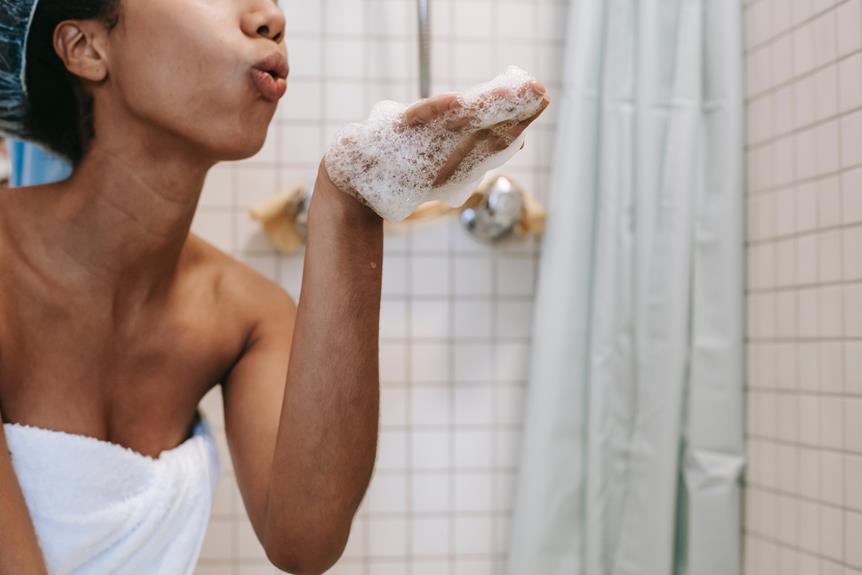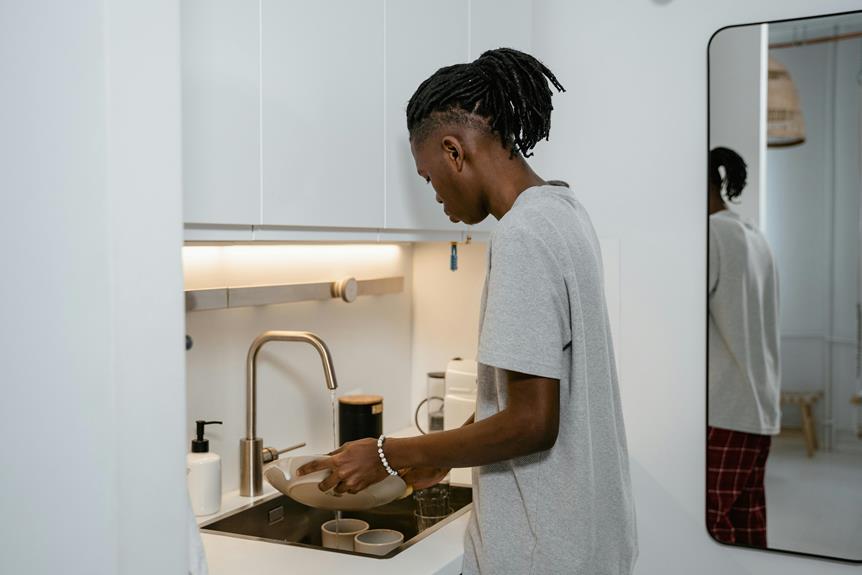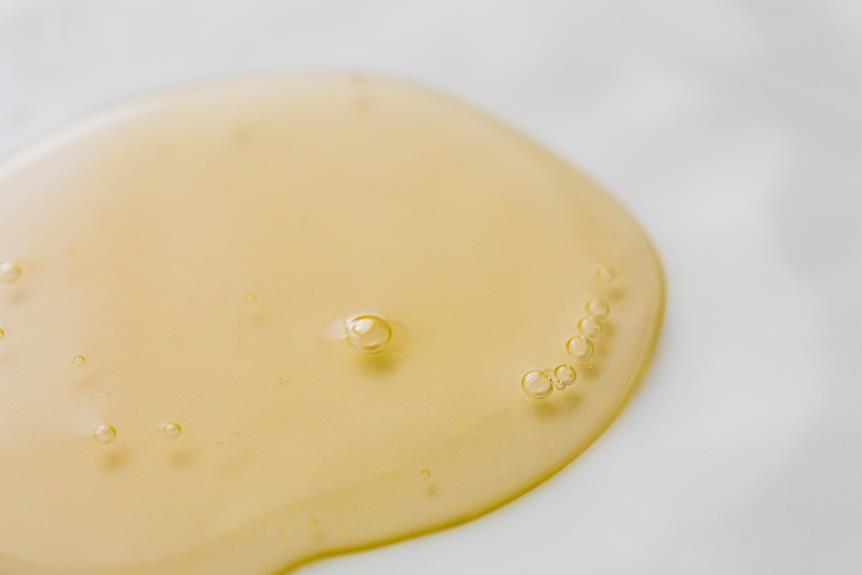Properly washing cornrows is essential for maintaining a healthy scalp and preserving the neatness of the style. This process requires a gentle approach to prevent unraveling or damaging the braids. By using sulfate-free shampoo, conditioning, and moisturizing techniques, one can effectively cleanse the scalp and nourish the hair.
Following a regular washing routine, typically every 7-10 days, is crucial for preventing breakage and maintaining overall scalp health. In this guide, we will explore the step-by-step methodology for washing cornrows, highlighting the importance of appropriate products and techniques to ensure the longevity and health of the style.
Key Takeaways
- Dilute shampoo with water before applying
- Use a shampoo designed for braids or cornrows
- Look for sulfate-free shampoos
- Prioritize moisturizing and clarifying properties
Preparing Your Hair
Use a small amount of diluted shampoo to prepare your hair for washing cornrows. It is essential to dilute the shampoo with water in a plastic tumbler before application. Opt for a shampoo specifically designed for braids or cornrows, as they are formulated to be gentler and avoid harsh detergents like SLS, which can strip the hair and scalp of natural oils.
Before applying the diluted shampoo, wet your hair thoroughly to ensure even distribution and effective cleansing. Gently rub the diluted shampoo between the rows using your fingertips, being careful not to cause friction that may lead to frizz or damage to the braids. Experiment with different washing techniques, such as diluting the shampoo with more water, to find the best method that works for you.
Additionally, consider using a braid spray to keep the braids moisturized and hydrated after washing. It is important to avoid using too many products to prevent buildup, which can weigh down the braids and lead to scalp issues.
Choosing the Right Shampoo
When it comes to choosing the right shampoo for washing cornrows, it's important to consider key factors such as gentleness, moisturizing properties, and the ability to prevent product buildup.
Look for sulfate-free shampoos to ensure a gentle cleansing experience that won't strip the hair of its natural oils.
Additionally, prioritizing moisturizing and clarifying properties can help maintain the health and appearance of cornrows.
Sulfate-Free for Gentle Cleansing
Select a sulfate-free shampoo specifically formulated for braids or cornrows to ensure gentle cleansing without causing scalp irritation or frizziness.
Sulfates, commonly found in regular shampoos, can strip the hair of its natural oils and cause dryness, leading to frizz and scalp irritation.
When choosing a sulfate-free shampoo, look for ingredients like sodium lauryl sulfoacetate or sodium cocoyl isethionate, which are milder alternatives for cleansing without compromising the hair's natural moisture.
These shampoos effectively remove dirt and buildup without causing excessive dryness or irritation.
Additionally, sulfate-free shampoos are gentle on the scalp and help maintain the integrity of the braids or cornrows.
Moisturizing to Prevent Dryness
Proper selection of a moisturizing shampoo is essential for preventing dryness and maintaining the health of cornrows. When choosing a shampoo, consider the following factors:
- Look for shampoos with gentle, moisturizing ingredients such as coconut oil, shea butter, or argan oil.
- Avoid shampoos containing harsh detergents like Sodium Lauryl Sulfate (SLS) to prevent frizz and tangling.
- Experiment with different brands and formulations to find the best match for your specific hair type and cornrow style.
- Prioritize shampoos specifically designed for dry or damaged hair, as they often contain extra moisturizing properties.
- Consider consulting with a hairstylist or trichologist for personalized recommendations based on your hair's unique needs.
Clarifying for Product Buildup
To effectively address product buildup while washing cornrows, it is crucial to choose a deeply-cleansing shampoo that targets the roots and the area where the braids and natural hair meet. Look for shampoos specifically designed for braids or cornrows and avoid those containing harsh detergents like SLS to prevent damage and promote hair growth.
When selecting a shampoo, consider using a moisturizing conditioner for dry hair and check the ingredients to ensure they won't cause buildup. Experiment with different brands to find what works best for you and use a shampoo foaming cleanse to avoid frizzing. Dilute the shampoo with water for better penetration and massage the shampoo thoroughly into the scalp, sliding the foam towards the tips of the braids to remove product buildup.
Washing Technique
Regularly washing your cornrows every 7-10 days is essential to maintain scalp health and promote healthy hair growth. When washing your cornrows, follow these steps for the best results:
- Mix sulfate-free shampoo, oil, and warm water in a spray bottle or small bowl and massage the shampoo into your scalp and braids
- Spray your cornrows with a protein-based conditioner solution and cover your head with a shower cap for 20 minutes
- Run your head under warm water to open up the cuticles and use a portable shower head for easier rinsing
- Pat your cornrows with a soft cotton towel and wear a shower cap to protect your cornrows while they dry
- Avoid rubbing your head to prevent undoing the braids and wring out the ends of your cornrows to remove excess moisture
Following these steps will help prevent breakage, maintain scalp health, and promote healthy hair growth.
It is important to use sulfate-free shampoos to avoid scalp irritation and frizziness, as well as conditioners with keratin to repair damaged cuticles and prevent dirt and residue buildup.
Conditioning Your Cornrows
For optimal maintenance of cornrows, begin by incorporating a protein-based conditioner, oil, and warm water mixture to deeply condition the hair and scalp. After washing your cornrows, apply the conditioner solution by spraying it onto your hair, ensuring even coverage. Then, cover your head with a shower cap and allow the conditioner to penetrate the cornrows for 20 minutes. This deep conditioning treatment helps nourish and strengthen the hair, keeping the cornrows looking healthy and vibrant.
To address specific hair concerns, choose oils such as olive or almond oil for combating dandruff or dryness in your cornrows. Alternatively, opt for argan oil if you have coarse, unruly hair. These oils can be added to the conditioner mixture for an extra boost of nourishment. Additionally, using keratin-infused products aids in repairing damaged cuticles and maintaining the overall health of your cornrows.
To highlight the benefits of proper conditioning, the table below summarizes the advantages of regular conditioning for cornrows:
| Benefits of Regular Conditioning |
|---|
| Retains natural oils |
| Prevents dryness and breakage |
| Strengthens and nourishes hair |
Drying Methods
When drying cornrows, it's important to consider the method that best suits your hair type and styling needs. Air drying can be gentle and less damaging, while blow-drying can provide quicker results.
Additionally, using a microfiber towel can help to minimize friction and prevent frizz.
Air Drying Vs. Blow-Drying
Choosing the appropriate drying method for cornrows depends on the hair type and personal preference. When deciding between air drying and blow-drying, consider the following factors:
Air Drying:
- Allows for natural preservation of the hair's integrity
- Reduces the risk of frizz and breakage
- Gentle method suitable for delicate cornrows
- Low-risk option for maintaining hair health
- Embraces the hair's natural texture and pattern
Blow-Drying:
- Can ensure thorough drying with low heat and low speed
- Should be done cautiously to prevent heat damage and breakage
- Offers a quicker drying process compared to air drying
- Requires careful attention to temperature and speed settings
- Suitable for individuals with a preference for styled and fully dried hair
Towel Drying Techniques
After rinsing the cornrows, carefully pat them with a soft cotton towel to remove excess water and avoid rubbing, aiding in the prevention of frizz and breakage. This gentle patting motion helps to remove moisture without causing damage to the delicate braids.
Additionally, using a microfiber towel can further aid in the drying process by absorbing excess water without causing frizz. It's important to avoid excessive rubbing, as this can lead to frizz and potential breakage.
If necessary, a blow dryer can be used on a low heat and low speed setting to ensure the cornrows are fully dry after patting them with a towel. Properly drying cornrows is essential for maintaining the style's neatness and preventing mold growth due to excess moisture.
Moisturizing Your Scalp
To effectively moisturize your scalp while wearing cornrows, consider the following steps:
- Apply a leave-in conditioner, oil, and water mixture directly to the roots and massage it into the scalp and braids. This will help to nourish and hydrate your scalp, preventing dryness and promoting healthy hair growth.
- Choose the right oil for your specific needs. Olive or almond oil can be effective for addressing dandruff or dryness, while argan oil is beneficial for managing coarse and unruly hair.
- Regularly moisturize your scalp to maintain the health and integrity of your hair. This helps to prevent breakage and brittleness.
- After applying the moisturizing mixture, gently massage your scalp to ensure that the product is evenly distributed and absorbed.
- Wrap your hair in a satin or silk scarf to further aid in retaining moisture and preventing dryness. This will contribute to the overall health and vibrancy of your cornrows.
Maintenance Tips
For optimal maintenance of cornrows, it is essential to incorporate regular scalp moisturization and protective measures to preserve the health and longevity of the style.
In addition to scalp moisturization, there are several maintenance tips that can help keep cornrows looking fresh.
Firstly, it is important to regularly moisturize the scalp using oils such as olive or almond oil for addressing dandruff or dryness, and argan oil for managing coarse, unruly hair.
A mixture of leave-in conditioner, oil, and water in a spray bottle can also be used for daily moisturizing.
Furthermore, protecting the cornrows while sleeping is crucial. This can be achieved by wrapping the hair in a satin or silk scarf to prevent dryness and maintain volume.
When washing cornrows, using a shower cap to protect them while they dry is recommended.
Frequently Asked Questions
Can I Wash My Cornrows With Regular Shampoo, or Do I Need a Special Kind for Braided Hair?
It is advisable to use a shampoo specifically designed for braided hair to avoid causing friction and frizz. Regular shampoo can lead to tangling and frizz due to its formulation. Look for gentle, moisturizing shampoos to maintain the integrity of your cornrows.
Is It Okay to Wash My Cornrows Every Day, or Should I Wait a Few Days Between Washes?
It is recommended to wash cornrows every 7-10 days to maintain scalp health and prevent breakage. Over-washing can strip natural oils, while under-washing can lead to product build-up. Find a balance to promote healthy hair growth.
How Can I Prevent My Cornrows From Getting Frizzy After Washing?
To prevent frizziness after washing cornrows, use a sulfate-free shampoo diluted with water for gentle cleansing. Follow with a moisturizing conditioner to maintain hydration. Protect the style with a satin or silk scarf and avoid friction by using a foaming shampoo specifically designed for braided hair.
Should I Use a Leave-In Conditioner on My Cornrows After Washing, or Is Regular Conditioner Enough?
When considering the use of a leave-in conditioner on cornrows after washing, it's essential to prioritize moisture retention and protection. While regular conditioner suffices, a leave-in conditioner can offer added hydration and safeguard against dryness and breakage, promoting overall hair health.
What Can I Do if My Scalp Feels Dry and Itchy After Washing My Cornrows?
To alleviate dryness and itchiness after washing cornrows, consider using olive or almond oil, argan oil for coarse hair, and sulfate-free shampoo to prevent scalp irritation. A mixture of leave-in conditioner, oil, and water can also provide moisturization.
Conclusion
In conclusion, washing cornrows is essential for maintaining scalp health and preventing breakage. By using a sulfate-free shampoo, protein-based conditioner, and a moisturizing oil and water mixture, you can keep your cornrows clean and well-nourished.
Wrapping your hair in a satin or silk scarf will help maintain the style and prevent dryness. Regular washing and moisturizing every 7-10 days will keep your cornrows looking and feeling their best.
ablison.com/wp-content/uploads/2023/11/post_surgery_hair_care_tips.jpeg” class=”crp_featured crp_thumb crp_thumbnail” alt=”post surgery hair care tips” title=”How to Wash Hair After Breast Augmentation” srcset=”https://www.ablison.com/wp-content/uploads/2023/11/post_surgery_hair_care_tips.jpeg 960w, https://www.ablison.com/wp-content/uploads/2023/11/post_surgery_hair_care_tips-300×180.jpeg 300w, https://www.ablison.com/wp-content/uploads/2023/11/post_surgery_hair_care_tips-768×460.jpeg 768w” sizes=”(max-width: 150px) 100vw, 150px” srcset=”https://www.ablison.com/wp-content/uploads/2023/11/post_surgery_hair_care_tips.jpeg 960w, https://www.ablison.com/wp-content/uploads/2023/11/post_surgery_hair_care_tips-300×180.jpeg 300w, https://www.ablison.com/wp-content/uploads/2023/11/post_surgery_hair_care_tips-768×460.jpeg 768w” />How to Wash Hair After Breast Augmentation






